Abstract
Exposure therapy approaches are recognized as effective treatments for specific phobias; however, certain phobias, such as fear of driving on urban highways, present unique challenges in order to expose the patient to the triggering stimuli in a safe, accessible, and controlled manner. In this context, we developed a virtual reality (VR) computerized driving simulator based on a local urban highway, and an accompanying clinical protocol to provide exposure therapy for patients with observed fear of driving on urban highways. We recruited eleven patients for this pilot study, where safety and tolerability as well as clinical and functional improvement were explored. We found that the driving simulator was safe and well tolerated by patients, with a notable 82% of patients successfully completing in vivo exposure, and there being a consistent trend in reduced anxiety scores using standardized testing. Nine patients successfully engaged in live exposures in a real freeway after participating in this VR-based exposure therapy protocol. The creation of an immersive and realistic VR environment based on a local urban highway for treating this phobia proved feasible and well-tolerated by participants. The intervention’s ability to engage patients who might otherwise have avoided traditional exposure therapies is noteworthy. Future research should aim to replicate this study with a larger and more diverse sample to enhance the generalizability of the findings.
1. Introduction
A specific phobia is an intense, excessive, and irrational fear of a specific object or situation, triggering an immediate anxious response in the patient [1]. This behavior leads to anticipatory anxiety and avoidance of the trigger, negatively impacting their quality of life. Common examples include exposure to certain animals, blood, heights, flying, and driving on highways [1,2]. While anxiety disorders in general are the most prevalent psychiatric illnesses among the general population, specific phobias altogether are the most prevalent type of anxiety disorders, with reported lifetime prevalences between 6% and 12% of the population [2,3]. In Santiago, Chile, urban highways have been quickly developed over the last two decades, noticeably changing the way that people travel within the city, with the risk of becoming isolated if unable to use them [4].
In clinical practice, our colleagues at the Pontifical Catholic University of Chile, as well as those at other clinical and academic institutions in Santiago, have observed a consistent trend in recent years: a higher occurrence of specific phobias related to driving on highways. This is consistent with findings reported in the literature [5]. This observation sparked interest in developing a treatment protocol to address this clinical issue.
Specific phobia to driving can be treated with exposure therapy, a technique where the patient is progressively exposed to the trigger under controlled conditions, and which has been widely recognized for its effectiveness in reducing phobic anxiety responses and associated avoidance behaviors [3,4,5,6,7,8]. However, in vivo exposure to highways raises questions of patient, caregiver, and overall public safety, along with increased time and cost demands, which challenges therapists in their ability to effectively treat their patients. In order to address these concerns, virtual reality (VR) poses itself as an attractive solution: VR is a computer-generated three-dimensional scenario in which the user interacts naturally with a virtual environment using stereoscopic vision goggles and pointing devices, allowing for movement and manipulation of objects emulating a real-world experience [9]. Virtual reality offers a unique and controlled environment for reconstructing real-world scenarios, allowing researchers to measure various variables such as stress, fear, reaction time, and perception in different contexts and with diverse target users. Its application in driving phobia treatment is particularly promising as it allows for safe and repeatable exposure to anxiety-provoking situations [10]. These characteristics, when adequately implemented, allow for immersive experiences which have proven ideal for training, simulation, education, as well as therapeutic applications [11].
Since the early 1990s, numerous studies, reviews, and meta-analyses have provided evidence on the utility of VR-based therapies for various clinical conditions, particularly for phobic anxiety disorders [12]. Notable among these studies are randomized controlled trials on the effectiveness of VR-based exposure therapies (VRET) for treating agoraphobia [13,14,15,16], social phobia [17], small animal phobias [18], spider phobias [19,20,21], specific phobias of flying and heights [22,23], as well as other specific phobias [24]. A meta-analysis by Morina et al. [25] supports that VRET can produce significant behavior change in real-life situations and supports its application in treating specific phobias. A more recent meta-analysis [26] underscores the added value of VR applications over waiting-list or psychoeducation-only control groups. Most of the studies included in these meta-analyses show results for VR exposure therapy for phobic anxieties superior to placebo, and comparable to traditional cognitive-behavioral therapy frameworks, with the advantages of accessibility, safety, and ease of treatment.
Despite fear of driving being common in the general population, leading to serious constraints in everyday life, there is still limited research into treatment of phobias specifically related to driving on highways [27]. Preliminary evidence was reported by Wald and Taylor [28,29], who first suggested that VRET could be useful in treating driving phobia in a case report with one participant, and later supported their findings with more participants. Walshe et al. [30] studied the effects of a VR driving program in a small group of patients with a specific kind of driving phobia induced by an accident, reporting a decrease in anxiety measures. More recently, da Costa et al. [31] tested a custom virtual driving software, version 1.3.8, in a group of patients and reported a decrease in the frequency of distorted thoughts and state anxiety scores, as well as a slight improvement in quality of life. Kaussner et al. [32] focused on behavioral effects of VRET on patients with fear of driving as measured by a post-treatment driving test in real traffic, reporting positive results as all patients mastered driving tasks they had avoided before. A systematic review [33] concluded that VR based psychological treatments may be feasible and acceptable to patients with driving phobia, and that there is potential to increase accessibility to psychological therapies in patients with driving phobia using digital technologies such as VR.
The specific scenario of driving on urban highways has not been sufficiently addressed yet; this is a growing clinical problem in cities where inner-city high-speed roads have proliferated in recent years. As recent literature shows, the experimental processes and the virtual reality (VR) driving scenarios need to be appropriately adapted to reflect realistic scenarios causing this fear of driving [34]. In this context, we aimed to design and implement a VR computerized driving simulator based on a local urban highway, as well as a VR-based clinical protocol to provide exposure therapy for patients with fear of driving on urban highways.
2. Materials and Methods
2.1. Subjects
Participants were recruited through a newspaper article about highway phobia and this pilot study. There were no financial incentives for either participants or clinical researchers. Individuals were required to contact the research team through the clinic’s call center. A questionnaire was handed out to each of them in order to assess their fitness for the study. We considered the following as inclusion criteria: specific phobia to driving on highways according to DSM-5 criteria, age over 18 years old (the legal driving age in Chile), and having a valid driver’s license. The exclusion criteria were severe medical conditions or medications that would pose a risk to driving or to exposure to VR, and any non-compensated concomitant psychiatric disorder (excluding those who are related to the fear of driving on highways, such as other anxiety disorders or related phobias). Originally, a sample of 36 patients that met inclusion criteria and did not meet exclusion criteria was recruited. However, after civil unrest in Chile in late 2019 and the COVID-19 pandemic, only 11 of them were available to resume participation in the study from November 2020 to September 2021. All participants signed a written informed consent according to the approved protocol by the local Ethics Committee.
2.2. Clinical Assessments
To confirm the diagnosis of specific phobia, a clinical evaluation was carried out by a psychiatrist using the SCID-I questionnaire, phobia section [35], to confirm a diagnosis of highway phobia, as well as the Mini International Neuropsychiatric Interview (MINI) [36], to confirm any other concomitant psychiatric disorder. Anxiety and avoidance were rated by the Hamilton Anxiety Scale [37] and the Agoraphobia Inventory (IA), adapted to the Chilean population [38]. These two scales are standard for gauging anxiety responses.
In order to assess safety and tolerability, we defined perceived safety by the subject as an anxiety response that is lower in severity compared to the original symptoms, both in a virtual environment and in real-life exposure. We also asked patients to report unwanted side effects to VR exposure, such as disorientation, dizziness, headaches, nausea, sweating or tremors. In case of severe physical and/or emotional discomfort, a crisis intervention protocol was prepared, but was not needed.
2.3. Devices and Design of VR Driving Simulation Program
A specially designated room at Clínica Las Condes was adapted for this purpose, with a standard car seat, and a Logitech G27 Steering Wheel Kit (Manufactured by Logitech, 7600 Gateway Blvd, Newark, NJ, USA; Assembled in China), which included a 900° rotation steering wheel with force feedback, a pedal set, and a gear shifter (Figure 1). An Oculus Rift Development Kit 2 (DK2) VR headset (Designed by Oculus VR, Long Beach, CA, USA; Assembled in China), with IR position tracking cameras, was used by participants in this VR driving simulator (Figure 2). An additional screen was used by the caregiver to supervise treatment.
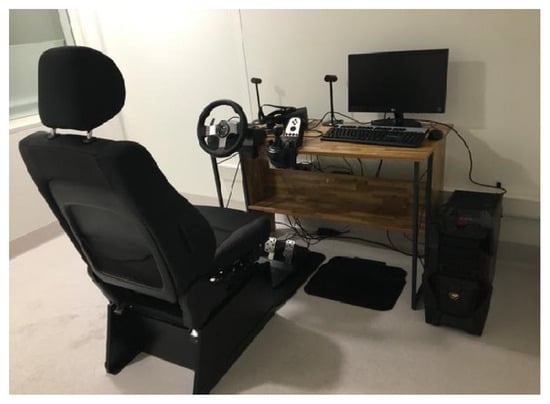
Figure 1.
Hardware setup for VR exposure.
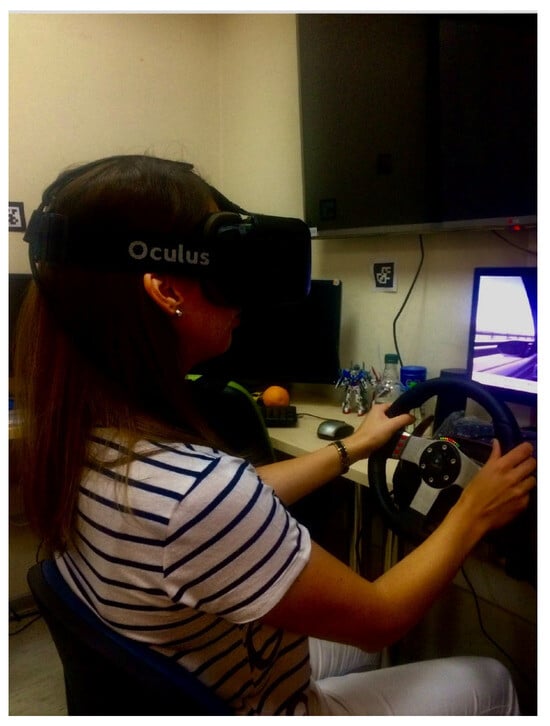
Figure 2.
Hardware usage demonstration with VR goggles.
The custom software, version 1.3.8, was developed in-house by a team of engineers, using the Unity3D graphics engine version 5.4f1 (Unity Technologies, San Francisco, CA, USA) and 3DStudio Max 2015 (Autodesk, San Francisco, CA, USA) for asset creation, such as signage, vegetation, buildings, and other accoutrements. The highway was modeled after the Costanera Norte urban highway in Santiago, Chile, using height maps and satellite imagery from Google Earth for accuracy (Figure 3 and Figure 4). All hardware devices were fully integrated, allowing for unrestricted camera orientation and all functions of the steering wheel kit—gear shifting, realistic handling and force feedback—were incorporated to enhance the simulation’s realism and interactivity.
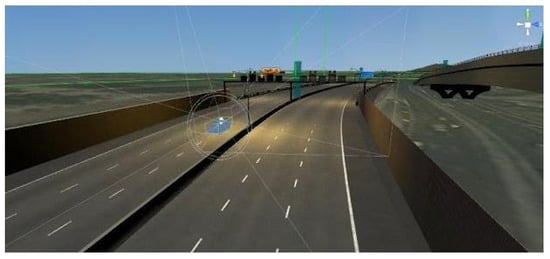
Figure 3.
Unity3D render of the Costanera Norte freeway, shown in birds eye view.
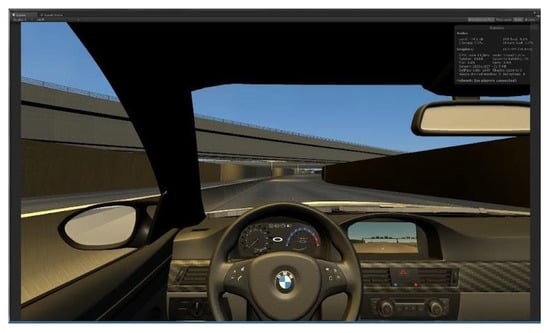
Figure 4.
Patient perspective from render on Figure 3.
As requested by our team of clinicians, the VR environment was set to be adaptable to the needs of the treatment process by altering four different environment variables:
- Time of day—daytime, sunset, nighttime.
- Weather—clear, cloudy, rainy.
- Traffic—light, moderate, heavy.
- Discrete events—presence of accidents, vehicles with sirens, reckless driving.
2.4. Clinical Protocol for VR-Based Exposure Therapy
A clinical protocol for providing exposure therapy to patients with phobia to drive in highways (Figure 5), using the locally designed VR driving simulator, was developed by a team of psychologists and psychiatrists that participated in the Anxiety Disorders Unit at Clínica Las Condes (between 2016 and 2020). This protocol included six stages:
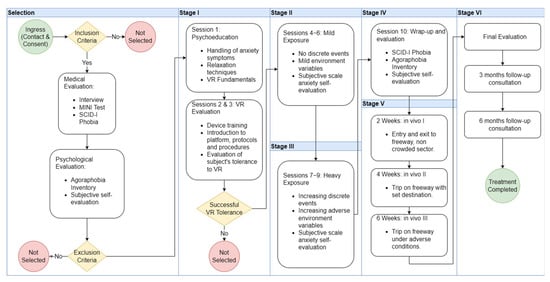
Figure 5.
VR clinical protocol flowchart.
- Psychoeducation and training (1 session): subjects are trained in VR use and educated in acute anxiety management and relaxation techniques.
- Trial runs (2 sessions): subjects are exposed to VR for short durations under supervision.
- Mild exposure (3 sessions): subjects are exposed to the VR environment under mild environment conditions and no discrete events.
- Heavy exposure (3 sessions): subjects are exposed to the VR environment under adverse weather conditions and with discrete traffic events.
- Evaluation and closure (1 session): subjects are evaluated using the SCID-I and IA scores, as well as the subjective 1–10 scale in order to assess improved anxiety response immediately after the end of the treatment.
Each session lasted 45 min, of which 20 min were dedicated to VR exposure, while the frequency of sessions was once a week. Follow-up evaluations were planned to assess both treatment success and sustained improvement. Participants were asked to enroll in several degrees of in vivo exposure, and success in doing so was checked two, four, and six weeks after the end of VR sessions.
2.5. Statistical Analysis
Considering sample size, the non-parametric Wilcoxon test was used to assess if differences between pre- and post-treatment evaluations were statistically significant.
3. Results
A VR driving simulator program that generates an immersive experience of driving on a local highway was successfully designed and implemented. After proving to be safe and tolerable in a group of 5 healthy control subjects, 36 patients were initially recruited for the study. Only 2 of these 36 participants (5.36%) withdrew from the study due to adverse events, particularly dizziness. The VR setting was well tolerated for the rest of the participants, but many withdrew due to the COVID-19 pandemic. Finally, 11 patients with specific phobia to drive in highways were enrolled and completed both the VR-based exposure therapy and study assessments. The mean age of this sample was 42 ± 13.2 years, with a gender distribution of 73% female and 27% male. Four patients (36%) had a prior history of panic attacks, and three patients (27%) had a prior history of major depressive disorder.
A trend towards a decrease in the global anxiety score on the Agoraphobia Inventory (AI) was observed, from 88.1 ± 43.8 to 77.9 ± 45.1 points (Figure 6). This result represents a decrease in the total test score from the 66th to the 59th percentile according to national norms. A trend towards a decrease in motor anxiety scores was also observed, both alone (from 36.5 ± 17.8 to 35.3 ± 24.9 points) and accompanied (from 22.5 ± 13.9 to 21.2 ± 16.9 points). This trend can also be found in the levels of psycho-physiological anxiety, both in frequency (from 31.4 ± 18.1 to 28.3 ± 12.1 points) and in degree of fear (from 35.1 ± 23.2 to 29.8 ± 18.9 points). Regarding the Echeburrúa cognitive subscale score, a decrease was also observed, from 20.2 ± 12.2 to 14.4 ± 12.1 points.
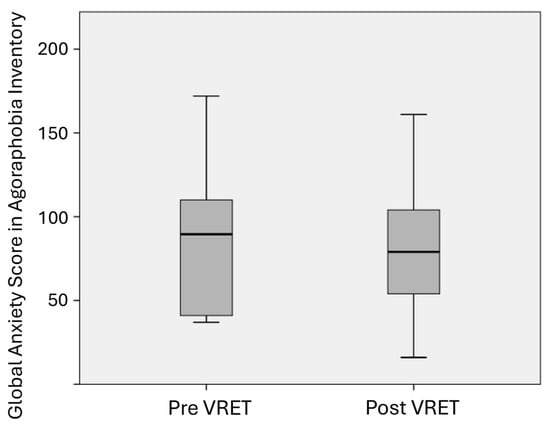
Figure 6.
Global anxiety scores of subjects according to Agoraphobia Inventory scores.
Similarly, the Hamilton Anxiety Scale showed a consistent trend towards a decrease, from 21.4 ± 8.8 to 17.9 ± 8.5 points (Figure 7):
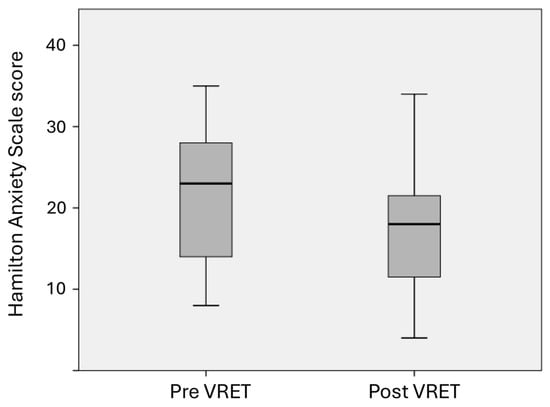
Figure 7.
Hamilton test scores for subjects after undergoing treatment.
Despite a sustained trend towards a decrease in all anxiety scales and subscales used, none of these changes were statistically significant when applying the Wilcoxon test. This is expected, given the exploratory nature of this pilot study, with insufficient power to detect significant changes, due to the relatively low sample size and significant variability among the results of different subjects.
Nonetheless, it is noteworthy to show that 9 of the 11 patients that completed VR-based exposure therapy subsequently managed to engage in some degree of in vivo exposure (Table 1) by driving on a real highway, representing 82% of the total sample. Of these, 6 out of 9 patients achieved the maximum proposed level of in vivo exposure, which involved entering the highway with one of the elements each patient considered the most difficult, representing 66% of patients that completed the VR-based treatment.

Table 1.
Participation log per patient for each activity described in the clinical protocol (yes/no). All participants successfully completed all ten VR exposure sessions, with nine of them undergoing in-vivo exposure and follow-up evaluations.
4. Discussion
The aim of developing a VR exposure platform and a VR-based treatment protocol to offer exposure therapy in a safe, accessible, and controlled manner was achieved. This effort involved psychotherapists, psychiatrists, and computer engineers, as well as other specialists, proving that an interdisciplinary approach can be useful to address complex clinical challenges.
The motivation for this research project, initiated with the support of the Innovation Center of Clínica Las Condes in 2019, arose from the clinical team’s observation of an increasing number of patients seeking help for their inability to navigate the expanding highway network in Santiago, Chile. Given Chile’s centralized nature, many individuals must travel to the capital and use these highways, a trend expected to rise as the country develops. We believe that this situation might be happening in other countries as well. When the possibility of being enrolled in this study was published in a local newspaper, without offering financial incentives for participants, the clinic’s call center received over 600 calls for this study [39]. This highlights the often invisible limitations in autonomy experienced by individuals with specific phobias. These phobias are frequently underreported due to embarrassment, as they hinder activities considered trivial by others [40]. Specific phobias are typically not part of standard psychiatric or psychological assessments.
The creation of an immersive and realistic VR environment proved feasible and well-tolerated by participants. All measures of anxiety showed a trend to lower scores after participating in the VR-based exposure therapy, but with large variability in anxiety scores between different patients. Interestingly, nine patients (82%) successfully engaged in live exposures in a real freeway after participating in this VR-based exposure therapy protocol. The intervention’s ability to engage patients who might otherwise avoid traditional exposure therapies is notable and could be considered as a binding connection for patients that would initially refuse but would benefit from live exposure therapy. The methodology used in this study is replicable in other contexts, particularly in urban areas with similar highway systems. The use of consumer-grade hardware makes it accessible to a wider range of clinics and research institutions, implementing an interdisciplinary team to design a program that considers local features.
However, several limitations should be taken into consideration. First, this pilot study was underpowered in looking for significant statistical differences; however, the sample sized included in this study (eleven participants) does not differ much from previous studies in this field. Wald and Taylor [28] first reported a case report with one participant, Walshe et al. [30] included seven patients immersed in the driving environments, and in the study by da Costa et al. [32] eight out of thirteen participants were able to complete the protocol. Kaussner et al. [32] treated fourteen patients, but only nine of them were in the intervention group. Despite the anxiety scales used in this study being standard for gauging anxiety responses, better measuring techniques are needed. The use of clinical biomarkers, such as heart rate, pupil dilation and salivary indicators could be considered in future research to address this issue [10]. A second limitation to consider is the lack of a control group, since this pilot study followed a before-and-after design, conceived mainly as a proof-of-concept. Therefore, the trends found regarding lower anxiety scores could possibly be due to confounding factors that we cannot rule out, such as time passing, instead of the intervention. Among possible confounding factors, the study period partially overlapped with the COVID-19 pandemic, which may have influenced participants’ anxiety levels and driving behavior. However, the trends found here are consistent with previous reports in the literature regarding different scenarios of driving phobias reported by other authors in pre-pandemic times [30,31,32].
With all of this in mind, despite the preliminary promising results, it is necessary to assess the efficacy of this program in a larger randomized controlled study in order to conclusively affirm that it can be helpful to patients suffering from a specific phobia to drive on highways. Future research should also aim to assess efficacy of this exposure therapy protocol based in a VR driving simulator with a larger and more diverse sample, which would be important to improve the generalizability of the findings. In this larger study, specific assessments for highway phobias would provide more accurate and relevant measures of treatment efficacy. Long-term follow-up studies are essential to evaluate the durability of treatment effects and identify any potential relapse. Also, qualitative analysis that captures the subjective experience of patients enrolled for this VR-based exposure treatment would be helpful in understanding the meaning that such treatment represents for them, as well as the development of better testing methods that can more accurately gauge the anxiety response of the subjects.
In conclusion, this project supports the feasibility of using VR in treating highway driving phobia and is a good example on how a local scenario could be designed to treat patients in a specific location. This was accomplished by developing VR software that integrates digital topography scanning of a real highway in Santiago, Chile, along with the development of a clinical treatment protocol targeted at individuals diagnosed with this phobia. The collaborative effort of this interdisciplinary research team, combining the contributions of psychologists, psychiatrists, computer engineers, and graphic designers, provides promising results for a number of subjects; however, further research is warranted to validate these findings, as well as to explore broader applications of VR in mental health treatment.
Author Contributions
Conceptualization, F.M., L.M.G., R.S., J.F. and R.N.; software, J.F.; investigation, F.M., L.M.G., R.S., J.F. and R.N.; data curation, F.M., P.P. and R.N.; writing—original draft preparation, F.M., L.M.G., R.S. and P.P.; writing—review and editing, F.M. and R.N.; project administration, F.M. All authors have read and agreed to the published version of the manuscript.
Funding
This research received no external funding. Technical resources and required devices were provided by the Innovation Center at Clínica Las Condes.
Institutional Review Board Statement
The study was conducted in accordance with the Declaration of Helsinki, and was approved by the Ethics Committee of Clínica Las Condes, Santiago, Chile. The approval code A0322019AA was signed by the president of the Research Ethics Committee (local IRB) of Clinica Las Condes on 3 July 2019.
Informed Consent Statement
Informed consent was obtained from all subjects involved in the study.
Data Availability Statement
The raw data supporting the conclusions of this article will be made available by the authors upon request.
Acknowledgments
This project benefited from the contributions of many participants who are not co-authors of this publication but were part of it. Marcelo Gálvez, former Head of the Innovation Center at Clínica Las Condes, provided significant support for this project, and Lina Ortiz, former Head of the Adult Psychiatry Department at Clínica Las Condes, invited us to participate in this research. Rodrigo Erazo, also former Head of the Psychiatry Department and member of the Anxiety Unit at Clínica Las Condes, was involved in the project design and collaborated in initial medical interviews. Roberto Brücher also worked on the initial medical interviews, and psychologists Diego Casas-Cordero and María Paz Ardito applied the protocol to several participants. Gonzalo Rojas and Carlos Montoya were part of the team led by engineer Jorge Fuentes in the design of the VR highway driving simulator. Cristian Ramírez assisted in data analysis, and Benjamín Santelices was key in providing translations, document formatting, and style compliance. Although they do not meet criteria for authorship, we acknowledge their contribution to this interdisciplinary work. We thank everyone who participated in this project.
Conflicts of Interest
The authors declare no conflicts of interest.
References
- Diagnostic and Statistical Manual of Mental Disorders, 5th ed.; American Psychiatric Association: Washington, DC, USA, 2013.
- Craske, M.G.; Stein, M.B.; Eley, T.C.; Milad, M.R.; Holmes, A.; Rapee, R.M.; Wittichen, H.U. Anxiety disorders. Nat. Rev. Dis. Primers 2017, 3, 4. [Google Scholar] [CrossRef] [PubMed]
- Kessler, R.C.; Aguilar-Gaxiola, S.; Alonso, J.; Chatterji, S.; Lee, S.; Ormel, J.; Ustün, T.B.; Wang, P.S. The global burden of mental disorders: An update from the WHO World Mental Health (WMH) surveys. Epidemiol. Psichiatr. Soc. 2009, 18, 23–33. [Google Scholar] [CrossRef] [PubMed]
- Green, M.; Mora, R. Las autopistas urbanas concesionadas, una nueva forma de segregación. In ARQ (Santiago) Arquitectura De Infraestructura/Infrastructure Architecture; no. 60; Julio: Santiago, Chile, 2005; pp. 56–58. [Google Scholar] [CrossRef]
- Why We Fear Highways. Psychology Today. 2025. Available online: https://www.psychologytoday.com/ca/blog/extreme-fear/201002/why-we-fear-highways (accessed on 3 April 2025).
- Hamm, A.O. Specific phobias. Psychiatr. Clin. N. Am. 2009, 32, 577–591. [Google Scholar] [CrossRef]
- Grös, D.; Antony, M. The assessment and treatment of specific phobias: A review. Curr. Psychiatry Rep. 2006, 8, 298–303. [Google Scholar] [CrossRef]
- Antony, M.; Barlow, D. Specific phobias. In Anxiety and Its Disorders: The Nature and Treatment of Anxiety and Panic; Barlow, D.H., Ed.; Guilford Publications: New York, NY, USA, 2001; pp. 380–417. [Google Scholar]
- Li, B.; Zhang, R.; Kuhl, S. Minication affects action-based distance judgments in oculus rift HMDs. In Proceedings of the ACM Symposium on Applied Perception (SAP 2014), Vancouver, BC, Canada, 9–10 August 2014; pp. 91–94. [Google Scholar]
- Shirtcliff, E.A.; Finseth, T.T.; Winer, E.H.; Glahn, D.C.; Conrady, R.A.; Drury, S.S. Virtual stressors with real impact: What virtual reality-based biobehavioral research can teach us about typical and atypical stress responsivity. Transl. Psychiatry 2024, 14, 441. [Google Scholar] [CrossRef]
- Monge, J.P.; López, G.; Guerrero, L.A. Supporting Phobia Treatment with Virtual Reality: Systematic Desensitization Using Oculus Rift. In Advances in Human Factors and Ergonomics in Healthcare, Proceedings of the AHFE 2016 International Conference on Human Factors and Ergonomics in Healthcare, Orlando, FL, USA, 27–31 July 2016; Duffy, V., Lightner, N., Eds.; Advances in Intelligent Systems and Computing; Springer: Cham, Switzerland, 2017; Volume 482. [Google Scholar]
- Carl, E.; Stein, A.; Levihn-Coon, A.; Pogue, J.; Rothbaum, B.; Emmelkamp, P.; Asmundson, G.; Carlbring, P.; Powers, M. Virtual reality exposure therapy for anxiety and related disorders: A meta-analysis of randomized controlled trials. J. Anxiety Disord. 2019, 61, 27–36. [Google Scholar] [CrossRef]
- Pitti, C.T.; Peñate, W.; De La Fuente, J.; Bethencourt, J.M.; Roca-Sánchez, M.J.; Acosta, L.; Villaverde, M.L.; Gracia, R. The combined use of virtual reality exposure in the treatment of agoraphobia. Actas Esp. Psiquiatr. 2015, 43, 133–141. [Google Scholar]
- Castro, W.P.; Roca Sánchez, M.J.; Pitti González, C.T.; Bethencourt, J.M.; de la Fuente Portero, J.A.; Marco, R.G. Cognitive-behavioral treatment and antidepressants combined with virtual reality exposure for patients with chronic agoraphobia. Int. J. Clin. Health Psychol. 2014, 14, 9–17. [Google Scholar] [CrossRef]
- Malbos, E.; Rapee, R.M.; Kavakli, M. A controlled study of agoraphobia and the independent effect of virtual reality exposure therapy. Aust. N. Z. J. Psychiatry 2013, 47, 160–168. [Google Scholar] [CrossRef]
- Pelissolo, A.; Zaoui, M.; Aguayo, G.; Yao, S.N.; Roche, S.; Ecochard, R.; Gueyffier, F.; Pull, C.; Berthoz, A.; Jouvent, R.; et al. Virtual reality exposure therapy versus cognitive behavior therapy for panic disorder with agoraphobia: A randomized comparison study. J. Cyberther. Rehabil. 2012, 5, 35–43. [Google Scholar]
- Bouchard, S. Could virtual reality be effective in treating children with phobias? Expert. Rev. Neurother. 2011, 11, 207–213. [Google Scholar] [CrossRef] [PubMed]
- Botella, C.; Pérez-Ara, M.Á.; Bretón-López, J.; Quero, S.; García-Palacios, A.; Baños, R.M. In vivo versus augmented reality exposure in the treatment of small animal phobia: A randomized controlled trial. PLoS ONE 2016, 11, e0148237. [Google Scholar] [CrossRef] [PubMed]
- Miloff, A.; Lindner, P.; Hamilton, W.; Reuterskiöld, L.; Andersson, G.; Carlbring, P. Single-session gamified virtual reality exposure therapy for spider phobia vs traditional exposure therapy: Study protocol for a randomized controlled non-inferiority trial. Trials 2016, 17, 60. [Google Scholar] [CrossRef]
- Shiban, Y.; Schelhorn, I.; Pauli, P.; Mühlberger, A. Effect of combined multiple contexts and multiple stimuli exposure in spider phobia: A randomized clinical trial in virtual reality. Behav. Res. Ther. 2015, 71, 45–53. [Google Scholar] [CrossRef]
- Garcia-Palacios, A.; Hoffman, H.; Carlin, A.; Furness TA3rd Botella, C. Virtual reality in the treatment of spider phobia: A controlled study. Behav. Res. Ther. 2002, 40, 983–993. [Google Scholar] [CrossRef] [PubMed]
- Moldovan, R.; David, D. One session treatment of cognitive and behavioral therapy and virtual reality for social and specific phobias. Preliminary results from a randomized clinical trial. J. Evid.-Based Psychother. 2014, 14, 67–83. [Google Scholar]
- Triscari, M.T.; Faraci, P.; Catalisano, D.; D’Angelo, V.; Urso, V. Effectiveness of cognitive behavioral therapy integrated with systematic desensitization, cognitive behavioral therapy combined with eye movement desensitization and reprocessing therapy, and cognitive behavioral therapy combined with virtual reality exposure therapy methods in the treatment of flight anxiety: A randomized trial. Neuropsychiatr. Dis. Treat. 2015, 11, 2591–2598. [Google Scholar]
- Krijn, M.; Emmelkamp, P.M.; Biemond, R.; de Wilde de Ligny, C.; Schuemie, M.J.; van der Mast, C.A. Treatment of acrophobia in virtual reality: The role of immersion and presence. Behav. Res. Ther. 2004, 42, 229–239. [Google Scholar] [CrossRef]
- Morina, N.; Ijntema, H.; Meyerbröker, K.; Emmelkamp, P.M. Can virtual reality exposure therapy gains be generalized to real-life? A meta-analysis of studies applying behavioral assessments. Behav. Res. Ther. 2015, 74, 18–24. [Google Scholar] [CrossRef]
- Schröder, D.; Wrona, K.J.; Müller, F.; Heinemann, S.; Fischer, F.; Dockweiler, C. Impact of virtual reality applications in the treatment of anxiety disorders: A systematic review and meta-analysis of randomized-controlled trials. J. Behav. Ther. Exp. Psychiatry 2023, 81, 101893. [Google Scholar] [CrossRef]
- Fischer, C.; Heider, J.; Schröder, A.; Taylor, J.E. “Help! I’m Afraid of Driving!” Review of Driving Fear and its Treatment. Cogn. Ther. Res. 2020, 44, 420–444. [Google Scholar] [CrossRef]
- Wald, J.; Taylor, S. Efficacy of virtual reality exposure therapy to treat driving phobia: A case report. J. Behav. Ther. Exp. Psychiatry 2000, 31, 249–257. [Google Scholar] [CrossRef]
- Wald, J.; Taylor, S. Preliminary research on the efficacy of virtual reality exposure therapy to treat driving phobia. Cyberpsychol. Behav. 2003, 6, 459–465. [Google Scholar] [CrossRef] [PubMed]
- Walshe, D.; Elizabeth, L.; Kim, S.; O´Sullivan, K.; Wiederhold, B. Exploring the Use of Computer Games and Virtual Reality in Exposure Therapy for Fear of Driving Following a Motor Vehicle Accident. Cyberpsychol. Behav. 2003, 6, 3. [Google Scholar] [CrossRef] [PubMed]
- Da Costa, R.; Carvalho, M.; Ribeiro, P.; Nardi, A. Virtual reality exposure therapy for fear of driving: Analysis of clinical characteristics, physiological response, and sense of presence. Braz. J. Psychiatry 2018, 40, 192–199. [Google Scholar] [CrossRef]
- Kaussner, Y.; Kuraszkiewicz, A.M.; Schoch, S.; Markel, P.; Hoffmann, S.; Baur-Streubel, R.; Kenntner-Mabiala, R.; Pauli, P. Treating patients with driving phobia by virtual reality exposure therapy—A pilot study. PloS ONE. 2020, 15, e0226937. [Google Scholar] [CrossRef]
- Elphinston, R.A.; Vaezipour, A.; Fowler, J.A.; Russell, T.G.; Sterling, M. Psychological therapy using virtual reality for treatment of driving phobia: A systematic review. Disabil. Rehabil. 2022, 45, 1582–1594. [Google Scholar] [CrossRef]
- Trappey, A.; Trappey, C.V.; Chang, C.M.; Tsai, M.C.; Kuo, R.R.T.; Lin, A.P.C. Virtual Reality Exposure Therapy for Driving Phobia Disorder (2): System Refinement and Verification. Appl. Sci. 2020, 11, 347. [Google Scholar] [CrossRef]
- First, M.B.; Spitzer, R.L.; Williams, J.B.; Gibbon, M. Structured Clinical Interview for DSM-IV (SCID-I). In Clinical Version (SCID-CV) (User’s Guide and Interview); American Psychiatric Press: Washington, DC, USA, 1997. [Google Scholar]
- Sheehan, D.V.; Lecrubier, Y.; Sheehan, K.H.; Amorim, P.; Janavs, J.; Weiller, E.; Hergueta, T.; Baker, R.; Dunbar, G.C. The Mini-International Neuropsychiatric Interview (M.I.N.I.): The development and validation of a structured diagnostic psychiatric interview for DSM-IV and ICD-10. J. Clin. Psychiatry 1998, 59 (Suppl. 20), 22–33; quiz 34–57. [Google Scholar]
- Hamilton, M. The assessment of anxiety states by rating. Br. J. Med. Psychol. 1959, 32, 50–55. [Google Scholar] [CrossRef]
- Echeburúa, E.; Corral, P.; García, E.; Pérez, D.; Borda, M. Un nuevo Inventario de Agorafobia. Análisis Modif. Conducta 1992, 18, 101–102. [Google Scholar]
- Forno, M. Con un simulador de la Costanera Norte controlan el miedo a conducir por autopistas. Las Últimas Noticias, 29 December 2019. [Google Scholar]
- Howard, E.; LeWine, M.D. Phobia-Harvard Health. 2024. Available online: https://www.health.harvard.edu/a_to_z/phobia-a-to-z (accessed on 3 April 2025).
Disclaimer/Publisher’s Note: The statements, opinions and data contained in all publications are solely those of the individual author(s) and contributor(s) and not of MDPI and/or the editor(s). MDPI and/or the editor(s) disclaim responsibility for any injury to people or property resulting from any ideas, methods, instructions or products referred to in the content. |
© 2025 by the authors. Licensee MDPI, Basel, Switzerland. This article is an open access article distributed under the terms and conditions of the Creative Commons Attribution (CC BY) license (https://creativecommons.org/licenses/by/4.0/).